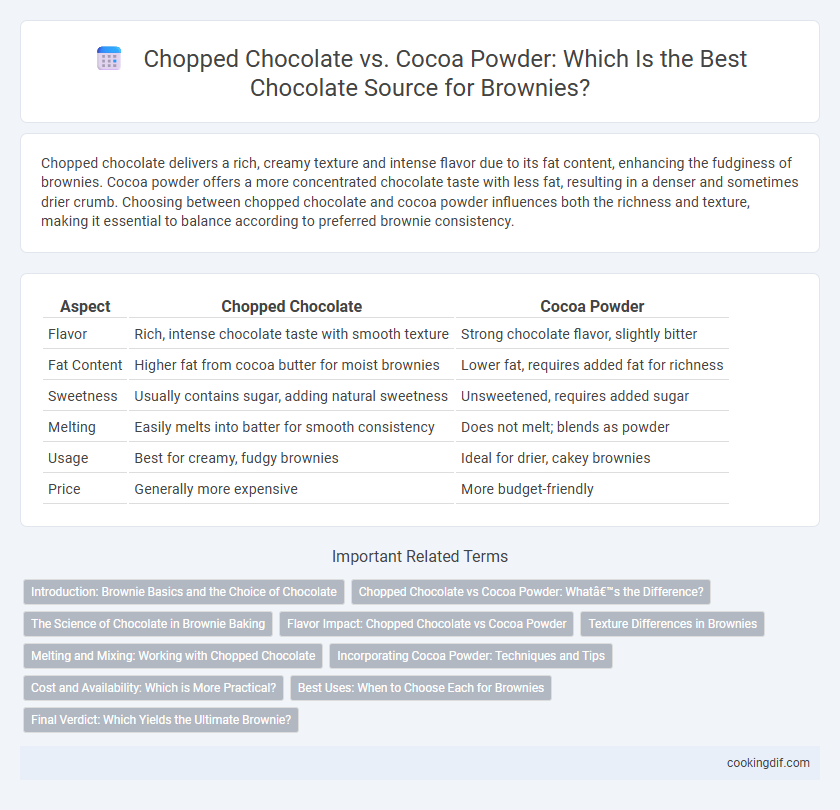Chopped chocolate delivers a rich, creamy texture and intense flavor due to its fat content, enhancing the fudginess of brownies. Cocoa powder offers a more concentrated chocolate taste with less fat, resulting in a denser and sometimes drier crumb. Choosing between chopped chocolate and cocoa powder influences both the richness and texture, making it essential to balance according to preferred brownie consistency.
Table of Comparison
| Aspect | Chopped Chocolate | Cocoa Powder |
|---|---|---|
| Flavor | Rich, intense chocolate taste with smooth texture | Strong chocolate flavor, slightly bitter |
| Fat Content | Higher fat from cocoa butter for moist brownies | Lower fat, requires added fat for richness |
| Sweetness | Usually contains sugar, adding natural sweetness | Unsweetened, requires added sugar |
| Melting | Easily melts into batter for smooth consistency | Does not melt; blends as powder |
| Usage | Best for creamy, fudgy brownies | Ideal for drier, cakey brownies |
| Price | Generally more expensive | More budget-friendly |
Introduction: Brownie Basics and the Choice of Chocolate
Brownie recipes typically call for either chopped chocolate or cocoa powder as the primary chocolate source, each impacting texture and flavor uniquely. Chopped chocolate contains cocoa butter, creating a richer, denser brownie with glossy crumb and intense chocolatey notes. Cocoa powder, lacking fat, lends a drier, cakier texture with a sharper, more concentrated chocolate taste ideal for lighter, fluffier brownies.
Chopped Chocolate vs Cocoa Powder: What’s the Difference?
Chopped chocolate contains cocoa solids, cocoa butter, and sugar, providing a richer texture and more intense chocolate flavor in brownies compared to cocoa powder, which is purely defatted cocoa solids offering a lighter, drier taste. Using chopped chocolate contributes to moist, fudgy brownies due to its fat content, while cocoa powder yields a denser crumb and sharper chocolate intensity without added fat. Understanding these differences helps bakers choose the best chocolate source to achieve their desired brownie texture and flavor profile.
The Science of Chocolate in Brownie Baking
Chopped chocolate contains cocoa solids, cocoa butter, and sugar, providing a balanced fat and flavor composition that melts smoothly, enhancing the brownie's moist texture and rich taste. Cocoa powder offers concentrated cocoa solids without fat, intensifying chocolate flavor but requiring added fats to ensure proper texture and tenderness in brownies. Understanding the fat content and melting behavior of each source is crucial in controlling the final crumb structure and mouthfeel in chocolate brownie baking.
Flavor Impact: Chopped Chocolate vs Cocoa Powder
Chopped chocolate provides a richer, creamier texture and intense cocoa flavor in brownies due to its higher fat content and natural cacao butter, enhancing the overall mouthfeel. Cocoa powder delivers a more concentrated, slightly bitter chocolate taste with less fat, resulting in a drier crumb and sharper flavor profile. Choosing between chopped chocolate and cocoa powder significantly affects the depth, texture, and flavor intensity of the final brownie.
Texture Differences in Brownies
Chopped chocolate creates a denser, fudgier texture in brownies due to its higher fat content and slower melting properties, resulting in pockets of gooey richness. Cocoa powder produces a lighter, more cake-like crumb by absorbing moisture and contributing a drier, slightly crumbly texture. Choosing between chopped chocolate and cocoa powder significantly influences the final brownie's mouthfeel and structural density.
Melting and Mixing: Working with Chopped Chocolate
Chopped chocolate melts smoothly when heated gently, providing a creamy texture essential for rich brownies, while cocoa powder requires mixing with fat to achieve a similar consistency. The solid form of chopped chocolate allows for better control during melting, preventing graininess and ensuring uniform incorporation into the batter. This results in a denser, fudgier brownie texture compared to the drier, more crumbly outcome from cocoa powder alone.
Incorporating Cocoa Powder: Techniques and Tips
Incorporating cocoa powder into brownies enhances their rich chocolate flavor while maintaining a fudgy texture by carefully sifting it with dry ingredients to prevent clumps. Using unsweetened, high-quality cocoa powder ensures deep chocolate notes, and combining it with melted butter or oil helps distribute it evenly for moistness. Adjusting the sugar level can balance cocoa's natural bitterness, resulting in a perfectly chocolatey, tender brownie.
Cost and Availability: Which is More Practical?
Chopped chocolate often costs more per ounce than cocoa powder but offers a richer, creamier texture in brownies and can be easier to measure and incorporate. Cocoa powder is generally more affordable, widely available, and has a longer shelf life, making it practical for frequent baking needs. For budget-conscious bakers seeking convenience, cocoa powder is more accessible, while chopped chocolate suits those prioritizing flavor depth despite higher costs.
Best Uses: When to Choose Each for Brownies
Chopped chocolate provides a rich, fudgy texture and intense flavor, ideal for dense, chewy brownies that require melting solid chocolate directly into the batter. Cocoa powder offers a lighter chocolate flavor and dry consistency, perfect for airy or cakey brownies where a less greasy texture is desired. Choose chopped chocolate for deep, moist brownies and cocoa powder when aiming for a tender crumb with complex chocolate notes.
Final Verdict: Which Yields the Ultimate Brownie?
Chopped chocolate in brownies provides a richer, creamier texture due to its higher fat content and cocoa butter, resulting in a fudgier and more intense chocolate flavor. Cocoa powder, while offering convenience and a deeper chocolate bitterness, tends to yield a drier, more cake-like brownie texture. For the ultimate indulgent brownie experience, chopped chocolate is the preferred choice.
Chopped Chocolate vs Cocoa Powder for chocolate source Infographic

 cookingdif.com
cookingdif.com